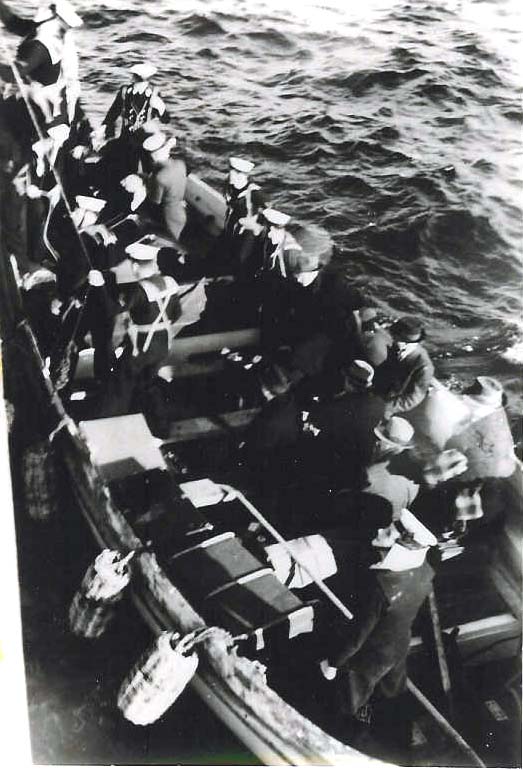Sunday 21 January 1940
 |
| Germans being taken off the Asam Maru. |
Winter War Air Operations: On 21 January 1940, Finnish Blenheim bombers, piloted by foreign volunteers, raid the Soviet naval base at Kronstadt. There are similar raids on the Soviet air base south of Tallinn and other Soviet bases in Estonia.
The Soviets bomb Finnish port Oulu.
Winter War Army Operations: The Soviets continue their artillery bombardment of Summa. They are firing 7,000 shells every day to soften the Finnish line preparatory to a full-scale assault. Otherwise, the action is quiet as the weather is still frosty.
 |
| Lines of barbed-wire obstacles stretch across snow-covered fields near Menin in France, 21 January 1940 (Imperial War Museum). |
U-22 (Kapitänleutnant Karl-Heinrich Jenisch) sinks Royal Navy destroyer HMS Exmouth (Captain Richard Stoddart Benson) off Tarbett Ness in the Moray Firth. All 175-189 (sources vary) crewmen perish. Jensch first tried to get the British freighter Cyprian Prince that the Exmouth was escorting but missed.
U-22 also torpedoes and sinks 1,469-ton Danish tanker Tekla. Nine perish (four in the ship, five when a mast falls on their lifeboat) and nine survive.
U-22 gets the third success during the day, but this one is from a mine that the U-boat laid on 20 December 1939 near Blyth in north-central England. The 1,086-ton British Ferryhill freighter sinks. Nine perish and two survive.
U-55 (it is believed) sinks Swedish freighter Andalusia. All 21 crew are lost. U-55 never returned from its patrol.
British freighter Protesilaus hits a mine laid by a U-boat and sinks.
British cruiser HMS Liverpool stops Asama Maru, a Japanese liner, off Honshu (35 miles from Japan) and takes off 21 German passengers (of 51 total Germans on board). The Germans are sailor survivors of the German liner Columbus that was scuttled off the US east coast on 19 December 1939). They are returning to Germany by a circuitous route. The men are considered suitable for military service and are to be taken to Hong Kong to be interned. The Japanese government is irate and sends destroyers to intercept the HMS Liverpool, so it makes top speed to the British base.
US freighter Nishmaha is detained by the British at Gibraltar (again).
Convoy OA 77 departs from Southend, Convoy OB 77 departs from Liverpool, Convoy HG 16F departs from Gibraltar and Convoy OG 15 forms at sea off Gibraltar.
British Government: The Duke of Windsor (former heir to the throne) steps down ("takes leave") from his duties as a liaison between the BEF and the French government.
Anglo/French Relations: The British Ministry of Information gives 8 French war correspondents a tour of the War Office, the Admiralty, the Air Ministry, and other key spots.
Holland: The government announces that leave for the military will soon be restored.
Norway: The government announces that 28 Norwegian-flagged ships have been lost.
Vatican: The Pope, Pius XII, broadcasts to the US about German atrocities against priests in Poland.
China: Ching-wei, the puppet ruler over Japanese-occupied China from Nanking, denies the veracity of a published document that supposedly shows that he has given the Japanese complete economic and political dominion over China. Two former associates of his published the supposed agreement.
Future History: Jack Nicklaus is born in Columbus, Ohio. He becomes nationally famous as a golfer in the late 1950s for performing well as an amateur in major tournaments and becomes internationally famous in the 1960s as he dominates the golfing world. Nicklaus goes on to become what many people consider to be the greatest golfer of all time, winning 18 Major Championships as a regular touring pro and many more as an amateur and Senior golfer.
 |
| The "Golden Bear," golfer Jack Nicklaus, born on 21 January 1940. |
January 1940
January 1, 1940: Finns Carve up the SovietsJanuary 2, 1940: Finnish Counterattacks Continue
January 3, 1940: Soviets Trapped
January 4, 1940: Soviet Breakout Attempts Fail
January 5, 1940: Dicing Up the Soviets
January 6, 1940: Soviet 44th Division Runs
January 7, 1940: Shakeup in Soviet High Command
January 8, 1940: Ratte Road Battle Ends
January 9, 1940: British Submarines in Peril
January 10, 1940: Mechelen Incident
January 11, 1940: Finns Surround More Soviets
January 12, 1940: New Soviet Attacks at Taipale
January 13, 1940: Fall Gelb Postponed
January 14, 1940: Japan's Government Falls
January 15, 1940: Soviets Prepare More Carefully
January 16, 1940: German Atrocities Uncovered
January 17, 1940: Bletchley Park in Action
January 18, 1940: New Hope for Allied Shipping
January 19, 1940: Finnish Attacks at Salla
January 20, 1940: Churchill Urges Cooperation
January 21, 1940: Asam Maru Incident
January 22, 1940: Dissension Within British Government
January 23, 1940: Dissension in South Africa
January 24, 1940: NKVD Blocking Detachments
January 25, 1940: Auschwitz Site Selected
January 26, 1940: Millionaire Bunker Destroyed
January 27, 1940: U-20 Sinks Four Ships
January 28, 1940: Softening Up the Finns
January 29, 1940: Moscow Willing to Talk
January 30, 1940: Hitler Throws Down the Gauntlet
January 31, 1940: Timoshenko Is Ready
2019
No comments:
Post a Comment